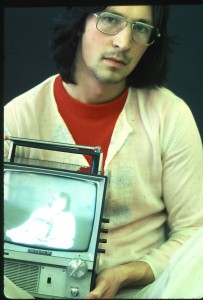A Sense of Myself
Artists have only recently begun to exploit the computer as a medium of expression and exploration. The work of Chris Meigh-Andrews is certainly in the forefront of such developments. He exploits his theme of self-imaging as a form of information , utilising a visuality that is neither photograph nor video.
In a recent gallery exhibition at the University of Central Lancashire, the artist presented images of himself made over a period of 20 years. His brief introduction to the show emphasised that the work was as much a reflection of his “changing attitude to making images” as it was a series of video and photographic self-portraits. Nevertheless “the linking theme…is that the same individual was on both sides of the camera”. Such stagings of the self- or, to be more accurate, its images- have a long pedigree, of course, and not only in the history of painting. Meigh-Andrews adds credence to a tradition of photographic self-portrayal in his allusion to Steichen’s Self-Portrait with Palette Brush (1903) in his own Man with Mouse (After Steichen ) 1994. Since the 1970’s, artists with a similar conceptual orientation to Meigh-Andrews- Cindy Sherman and Jo Spence, for example- have experimented with varieties of self-presentation.
The tenor of A Sense of Myself derives from the 70’s, a time when artists became less hidebound by traditional media and set about establishing a more fluid relationship between intuitive and critical awareness. Art-practice was based on a linguistic model: meanings were context-driven, installed (often literally) in a particular space and time. Inherent in such practice was the notion of the re-phrasable statement- a statement which, of its nature, was adjustable to, perhaps transformed by, a new context. For many artists, such procedures had an obsessively political bias, strangely at odds with their non-esentialist theoretical framework. Looking at Chris Meigh-Andrews’ work overall, one senses that his concerns tend to be built around himself, though in a quizzical, ironic manner. Some of his most successful pieces (for example On Being, 1985) have an eerily lyrical feel, the pressure of personal exposure, which is remote from the robotic stridencies of some of his contemporaries. Whether he is dealing with explicit self-portrayal or not, this artist returns again and again to the sphere of individual experience- its painful ephemerality, its immediacy, its elusivness. The chimerical nature of the self is agreed upon by many philosophers. Such apparently different thinkers as Hume and Sartre agree on its transitive character. Hume writes “When I enter most intimately into what I call myself, I always stumble on some particular perception or other”. Contemporary discourse focuses on the way in which the self is alienated; that to define self is to erase it. When we hear ourselves on tape or see ourselves in a photograph, we seem like someone else- a face-maker , a wearer of fashionable clothes and fshionable expressions. To all of these and many other puzzles, Meigh-Andrews addresses himself, not least the idea of self-images as something we hide behind.
Through the new medium of the computer, of CD-ROM, the artist has enormously enriched his theme. He is able to review, re-order and in some cases transform his work. The public exhibition of self, based on the gallery, becomes the domain of a private, active ‘reader’, who can interact with the material- looping sequences, resizing- ‘clicking and dragging’ as he browses through or interrogates these animated ‘pages’. Some of the work is simply re-presented; other projects (The Stockwell Sequence, 1977) are subject to addition; yet others (Mirrors, 1993) to radical distortion. The new medium allows ‘painterly’ freedom and placticity. In the artists own words it “pulls the work together like a hub”. But it also extends it, re-shapes it. In Venice Frames (1994) the history of self-hood is gathered into one portrayal- all those selves, all those times, defined anew. The complexity and the perilousnes of identity confront us in equal measure.
It is tempting to ask whether such self-presentation has a limit, at least of a psychological kind. Can an endlessly-improvised identity turn into a sort of fate? Is the illusion of a true self nevertheless indispensable? Meigh-Andrews’ briliant new work seems to volunteer a demonstration of the process by which we can, in a sense that is dificult to define, become an illusion to ourselves. In doing so, he makes our selfhood questionable- which is to say interesting – again.
IAN HARROW, Leeds, June 1994.
